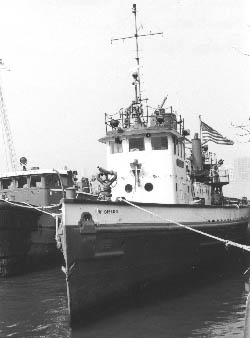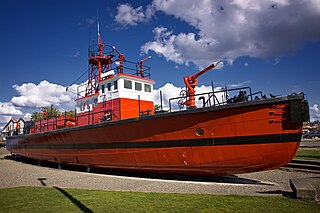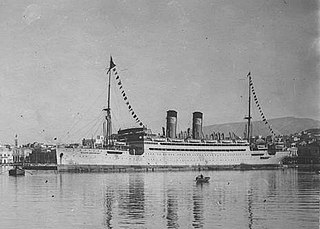
Duwamish is a retired fireboat in the United States. She is the second oldest vessel designed to fight fires in the US, after Edward M. Cotter, in Buffalo, New York.

A fireboat or fire-float is a specialized watercraft with pumps and nozzles designed for fighting shoreline and shipboard fires. The first fireboats, dating to the late 18th century, were tugboats, retrofitted with firefighting equipment. Older designs derived from tugboats and modern fireboats more closely resembling seafaring ships can both be found in service today. Some departments would give their multi-purpose craft the title of "fireboat" also.

John J. Harvey is a fireboat formerly of the New York City Fire Department in New York City, famed for returning to service following the September 11, 2001 attacks. She is among the most powerful fireboats ever built, capable of pumping up to 18,000 gallons of water a minute.

Fireboat No. 1 is a historic fireboat on display in a permanent land installation on the waterfront in the Old Town area of Tacoma, Washington. Built in 1929, she was for more than fifty years the sole firefighting vessel for the Port of Tacoma. She was designated a National Historic Landmark in 1980.

Ralph J. Scott, also formerly known as Fireboat #2, is a 100-foot (30 m) fireboat that was attached to the Los Angeles Fire Department serving the Port of Los Angeles. She was retired in 2003 after 78 years and replaced by Warner L. Lawrence. Ralph J. Scott is undergoing restoration near the Los Angeles Maritime Museum in San Pedro. On 30 June 1989, she was listed as a National Historic Landmark. She is currently located at the Los Angeles Fire Department, Fire Station 112, at 444 South Harbor Blvd, Berth 86, San Pedro, California.

The Alki is a fireboat noted for its long service in Seattle, Washington. The boat was built in 1927 and is 123 feet (37 m) long. She was Seattle's third fireboat. She was built with gasoline engines, which were replaced with diesels in 1947. The new engine retrofit allowed the Alki to increase its pumping capacity from 12,000 gallons per minute to 16,200 gallons per minute. She replaced the Snoqualmie, Seattle's first fireboat.

The Victor L. Schlaeger was a fireboat operated by the Chicago Fire Department from 1949 to 2010. While the city of Chicago had once operated nine powered fireboats, in the early 20th century, towards the end of her working life the Schlaeger was Chicago's sole large fireboat. She was supplemented by smaller, faster, but less capable boats. In 1986 she was retired from active to standby status, at a considerable savings in personnel, as she had been staffed 24 hours per day by a crew of eight.

The City of Long Beach, California started to operate a new fireboat, now known as the Protector, in May 2014. The vessel was known as Fireboat 20, until she was officially commissioned, on June 8, 2016. A sister ship will follow within a year. The two new vessels will replace the Challenger and the Liberty, commissioned in 1987. The earlier vessels had a troubled maintenance record. She will be one of the most powerful fireboats in the world.

The John Kendall was a steam-powered fireboat launched in 1929 by the Toledo Shipbuilding Company and operated by the Detroit Fire Department from 1930 to 1976. During her service as a fireboat she continued to be propelled by steam engines, requiring a crew of ten, five of whom were required to stoke her boiler. She was converted to a tugboat, and her steam engines were finally replaced by diesel engines. She served an additional 20 years as a tug, out of Alpena, Michigan. She was scrapped in 1994.

The Abram S. Hewitt was a coal-powered fireboat operated by the Fire Department of New York City from 1903 to 1958. She was the department's last coal-powered vessel and had a pumping capacity of 7,000 gallons per minute.

The Bravest is a fireboat operated by the Fire Department of New York City. She was commissioned on May 27, 2011.
William M. Feehan is a fireboat built for and operated by the New York City Fire Department (FDNY). Her namesake, William M. Feehan, was the oldest and most senior FDNY firefighter to perish in the line of duty on September 11, 2001. Her nameplate is carved from a steel plate salvaged from the collapse of the World Trade Center. The vessel's $4.7 million cost was largely covered by a FEMA Port Security Grant Program.

The Deluge was a fireboat operated, for decades, in Baltimore, Maryland. When built, in 1911, her capacity to pump 12,000 gallons per minute made her one of the most powerful fireboats.
The Portland Fire Bureau of the city of Portland, Oregon owns and operates Fireboats in Portland, Oregon.

The Snoqualmie was Seattle's first fireboat. She was the first fireboat on North America's west coast. She was launched in 1891, as a 98 feet (30 m) long, wooden-hulled, steam-powered vessel. She was taken out of service, and rebuilt when Seattle completed its second fireboat, the Duwamish, in 1909. Her coal-fueled boilers were replaced with oil-fueled ones. The retrofit included altering her profile. She had a new superstructure, and the replacement of her boiler meant replacing her original single smokestack with a pair of smokestacks. Built by Pacific Coast Engineering.

The Fire Department of New York operated a fireboat named William J. Gaynor from 1914 to 1961.

John Purroy Mitchel was a fireboat operated by the FDNY. She was named after former mayor of New York City, John Purroy Mitchel. Grace Drennan, niece of Fire Commissioner Thomas J. Drennan played a ceremonial role in the vessels launch on July 24, 1921. Her launch was also attended by current mayor John Francis Hylan.

The Thomas Willett was a fireboat operated by the FDNY. She was launched in 1908 and retired in 1959. She was built as a steam-engine powered vessel with coal-fired boilers. She was converted to oil-fired boilers in 1926.

The David A. Boody was a fireboat operated on the North River, the lower portion of the Hudson River, within New York state. She was built and commissioned in 1892 for the Brooklyn Fire Department and was operated by the BFD until Brooklyn's fleet was merged with that of nearby New York City.

The Thomas A'lessandro Jr. was Baltimore, Maryland's first diesel fireboat. She operated from 1956 to 2007. She was able to pump 12,000 gallons per minute.



















